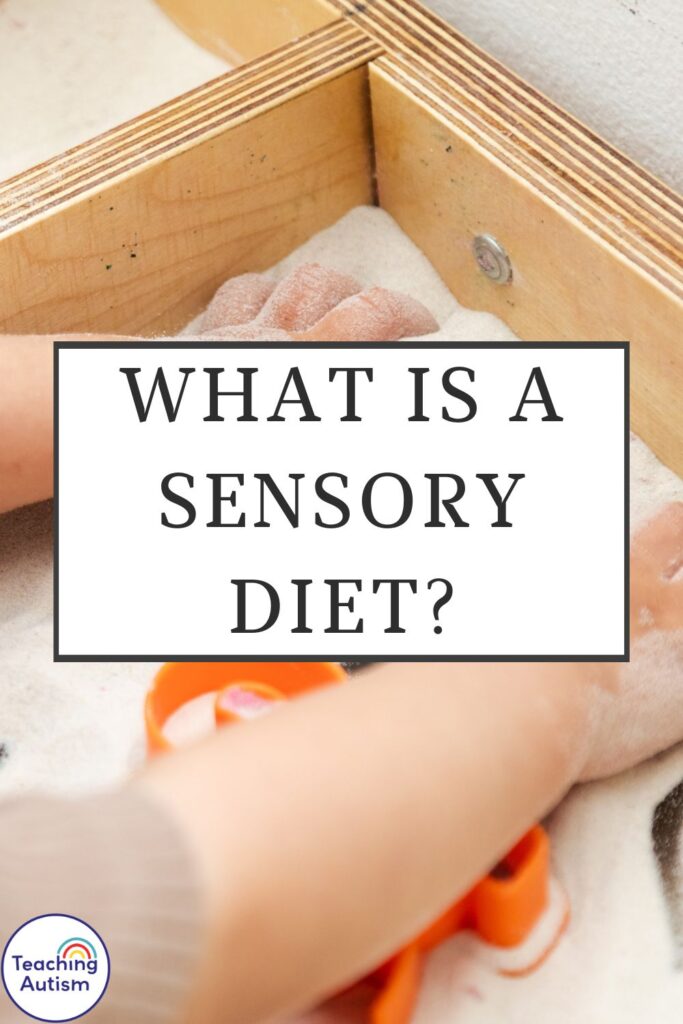What is a sensory diet? In this blog post I’m sharing all about what sensory diets are, how they are designed and some example activities you may find in a sensory diet.
What is a Sensory Diet?
A sensory diet is a set of activities or exercises that have been carefully designed for an individual to help meet their sensory needs.
This diet is created to meet the specific sensory needs of an individual. It can include a variety of activities like swinging, jumping, and even deep pressure, along with other sensory inputs. These activities all help to regulate the individual’s nervous system.
Who Has a Sensory Diet?
Sensory diets are usually used for individuals who have sensory processing difficulties. This can include individuals who are on the autism spectrum, have attention deficit hyperactivity disorder and others in the neurodivergent community.
Sensory diets are not age specific, meaning that we can get them created for any age.. children and adults.
What is the Goal of a Sensory Diet?
The goal of a sensory diet is to support the individual to feel more calm, focused and organized. All of this helps them to better engage in day to day activities.
The goal of a sensory diet is to help the individual feel more calm, focused, and organized, and to enable them to better engage in daily activities.
Who Designs Them?
Occupational therapists (OT) can ‘design’ a sensory diet. They will meet with the individual themselves.. And often family members and professionals who may work with the individual. There may be an assessment where they can observe the individual to gather information on their specific needs. From there, an OT can put together a sensory diet plan specific for that individual.
Different Types
Occupational therapists individualize sensory diets to cater to a person’s specific needs. If an individual is overstimulated, then their sensory diet will help to calm them down, allowing better concentration and focus.
But, if an individual is under-stimulated… Then their sensory diet will look much different because the goal is to help them feel more alert, active and engaged.
How Can I Help?
Once the sensory diet is set up, I’d highly recommend familiarizing yourself with everything that the OT has put together. You can also sit down with the OT and ask them any questions you have. Some of the ones I like to ask are;
- When should I do a routine with the student?
- What signs should I look for that they may need more time or another round of their sensory diet routine?
- How can I contact you if I need help?
- Should I be recording anything?
- How will I know if it’s working? Or not working?
Example Activities
The activities that are included in an individual’s sensory diet will be tailored specifically for them. But, there are often some crossovers where you may find similar activities on a few different sensory diet plans. Some activities that you may see included are;
- Somersaults / forward rolls.
- Snow angels.
- Pushing / pulling something heavy.
- Crab walks.
- Jumping jacks.
- Climbing ladders.
- Bouncing on a gym ball.
- Rolling gym balls up and down individual’s bodies.
An occupational therapist can also help you get access to any equipment that is needed to help follow the sensory diet plan in your classroom or too.
If you found this blog post helpful, please consider sharing it with your friends and colleagues on social media.
If you are looking for more sensory information, you may find the following helpful;
- What is Multi-Sensory Learning?
- 5 Multi-Sensory Room Must-Haves
- Why Sensory Play is Important
- What is a Sensory Lifestyle?
- Sensory Profiles and How to Create Them

P.S. Have you signed up for a 3 day free trial of my VIP membership yet? If not, click here to do it now and go and get access to a huge range of resources, templates, crafts and more for free.
Nikki
